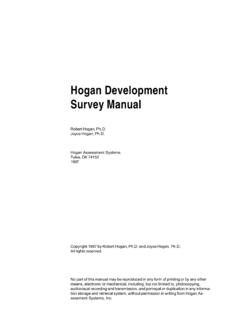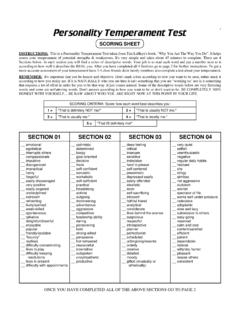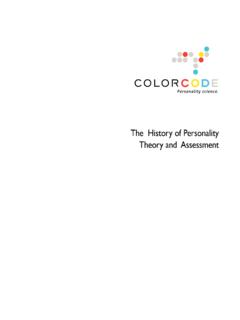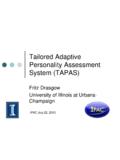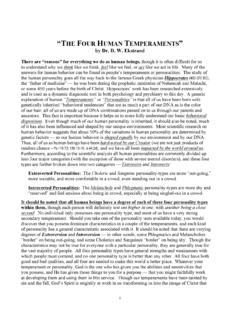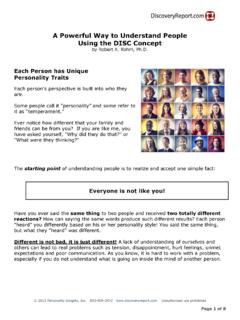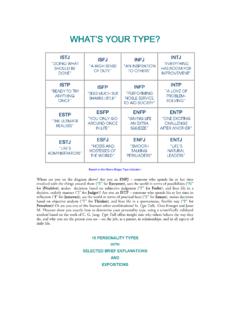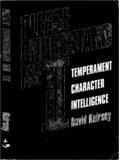Transcription of Hogan Personality Inventory Manual - Dr.BobHurley
1 Hogan Personality Inventory Manual Acknowledgements Over the last three years, a number of people have assisted us in the revisions of the Hogan Personality Inventory . The HPI would never have reached its level of development without their contributions and it is a pleasure to acknowledge them. At Hogan Assessment Systems, John Thompson programmed all test materials and data bases; he computed the statistical results that appear in the Manual . Various data sets were collected by Scott Gregory, John Morrison, Todd Murtha, Arvids Petersons, Brent Smith and Darryl Stark. P. Doody, M. Gooch, and B. Dings provided other valuable assistance along the way. We are especially indebted to colleagues who gave us benefit of their ideas on conceptual and technical issues. These include Gordon Curphy, Marvin Dunnette, Lewis Goldberg, Harrison Gough, Allan Harkness, Leaetta Hough, John Johnson, Auke Tellegen, Mark Schmit, and Jerry Wiggins.
2 At the University of Tulsa, Judy McHenry produced the written material, including design, layout, and graphics. We are grateful to all of these people for their assistance. Robert Hogan Joyce Hogan Tulsa 1992. Table of Contents Chapter 1 - Conceptual Introduction ..1. What to Measure ..1. The Five Factor Model ..2. How to Measure Personality ..3. How to Build a Scale ..4. Item Response Dynamics ..4. Socioanalytic Theory ..5. The Inevitability of the Five Factor Model ..5. A Viewpoint on Measurement ..6. Traditional Objections to Personality Assessment ..7. Response Sets ..7. Response Styles ..7. Summary ..8. Chapter 2 - Inventory Construction ..9. Early Development ..9. Later Development ..10. Definitions of the Scales ..12. Composition of the Personality Scales .. 13. Chapter 3 - Validity .. 19. Correlations with other Tests ..20. Adjustment ..21. Ambition ..26. Sociability ..27. Likeability ..28. Prudence.
3 28. Intellectance ..29. School Success ..30. Correlations between the HPI and Peer Descriptions ..31. HPI Correlates of Organizational Behavior ..34. Emotional Stability Factor: Adjustment .. 35. Surgency Factor: Ambition and Sociability ..36. Agreeableness Factor: Likeability ..36. Conscientiousness Factor: Prudence ..37. Culture Factor: Intellectance and School Success ..37. Chapter 4 - Interpreting and Using the HPI .. 39. How to Interpret the HPI ..39. Scale by Scale Interpretation ..39. Validity ..39. Adjustment ..40. Ambition ..41. Sociability ..41. Likeability ..42. Prudence ..42. Intellectance ..43. School Success ..43. Syndromes ..43. Delinquency .. 43. The Hollow Core ..44. Arrogance ..44. Creativity ..44. Sales ..45. Management ..45. Sample Profile Interpretations ..46. A Realistic Profile ..46. An Investigative Profile ..47. An Artistic A Social Profile .. 49. An Enterprising Profile ..50.
4 A Conventional Profile ..51. Ideal Uses of the HPI ..51. Career Counseling and Individualized Assessment ..51. Personnel Selection .. 52. Placement ..54. Promotion ..54. Succession Planning ..54. Summary ..54. Chapter 5 - Administering and Scoring .. 55. How to Administer Paper and Pencil HPI Forms ..55. Materials ..55. Completing the Answer Sheet ..55. Conducting the Testing Session ..55. Administrator's Script for Conducting a Testing How to Administer Computer On-Line Testing ..59. Materials ..59. Using the On-line System ..59. How to Score the HPI Answer Sheets ..60. Keyed Data Entry ..60. Optical Scanning of Answer Sheets ..60. Mail-in or FAX Scoring ..60. Testing Disabled Individuals .. 61. Chapter 6 - Occupational Scales and Validation Research .. 63. Introduction ..63. Description of the Occupational Scales ..64. Service Orientation Scale ..64. Stress Tolerance Scale ..65. Reliability Scale.
5 69. Clerical Potential Scale .. 70. Sales Potential Scale ..71. Managerial Potential How to Conduct Validation Research Using the HPI ..73. Job Analysis .. 74. Test Criterion Measures ..76. Statistical Analysis ..77. Implementation .. 77. References .. 83. List of Tables, Figures & Appendices Tables Table : Components of the Five Factor Model ..2. Table : Varimax Rotated Factor Matrix for HPI HICs .. 11. Table : HPI Scale and HIC Definitions and Sample Items .. 14, 15. Table : Descriptive Statistics and Reliabilities for HPI Scales and HICs .. 17. Table : HPI Scale Intercorrelations ..18. Table : Means and Standard Deviations for HPI Scales by Gender and Race .. 18. Table : Correlations between the ASVAB Composites and the HPI Scales .. 22. Table : Correlations between the PSI Basic Skills Tests and the HPI Scales ..22. Table : Correlations between the Myers-Briggs Type Indicator and the HPI Scales.
6 23. Table : Correlations between the Self-Directed Search and the HPI Scales ..23. Table : Correlations between the Inventory of Personal Motives and the HPI Scales ..23. Table : Correlations between the Interpersonal Adjective Scales and the HPI Scales ..24. Table : Correlations between the Big Five Factor Markers and the HPI Scales ..24. Table : Correlations between the MMPI-2 and the HPI Scales ..25. Table : Correlations between the PROFILE and the HPI Scales ..26. Table : Characteristics of Rated Personality Description Scales ..32. Table : HPI Scale Correlates of Rated Personality Descriptions ..33. Table : Adjectival Correlates of the HPI Scales .. 34. Table : A Guideline for Interpreting the HPI ..40. Table : Correlations between Alternate Forms of HPI Administration ..61. Table : Means and Standard Deviations for the HPI Occupational Scales ..65. Table : Additional Validity Studies for Service Orientation, Stress Tolerance, and Employee Reliability.
7 66, 67. Table : Adjectival Correlates of the HPI Occupational Scales ..68. Table : Sample Utility Results for HPI Occupational Scales ..82. Figures Figure : Performance Implications of the Five Factor Model ..35. Figure : Profile of a Realistic Type ..46. Figure : Profile of a Investigative Type ..47. Figure : Profile of a Artistic Type .. 48. Figure : Profile of a Social Type ..49. Figure : Profile of a Enterprising Type ..50. Figure : Profile of a Conventional Type ..51. Figure : Sample HPI Answer Sheet .. 56. Figure : Concurrent Validation Strategy ..74. Figure : Personality Related Job Analysis Abilities ..75. Figure : Data File Variable Specifications .. 78, 79. Appendices Appendix A: Norms for the Total Sample ..90. Appendix B: Norms for Selected Stratified Subgroups .. 93. Appendix C: Sample HPI Interpretive Report .. 105. Chapter 1. Conceptual Background Introduction The Hogan Personality Inventory (HPI) is a measure of normal Personality .
8 It is designed primarily for use in personnel selection, individualized assessment, and career-related decision making. It provides detailed information regarding what we call the bright side . of Personality characteristics that appear in social interaction and that facilitate or inhibit a person's ability to get along with others and to achieve his or her educational and occupational goals. Chapter Four contains information regarding how to use the HPI for individualized assessment and Chapter Three presents data regarding the validity of the HPI for these purposes. The HPI can also be used as a research instrument. Many research projects begin with the question, What is the relationship between Personality and X? , where X is leadership, creativity, integrity, academic performance, recidivism on parole, sales productivity, or some other performance outcome. If it is possible to develop a reliable quantitative index of individual differences in performance, then, in our experience, the HPI will usually predict it.
9 More specifically, the parts of the HPI that are conceptually related to the performance variable will predict it. Chapter Six provides a guide for doing research with the HPI. What to Measure All Personality assessment begins with the question, What should we measure? Histori- cally this question was answered by practical concerns or by the test author's personal interests. Practical concerns led to the development of the Woodworth Personal Data Sheet, the prototype of psychiatric screening devices. The Woodworth PDS, like its modern successors, , the Minnesota Multiphasic Personality Inventory (MMPI; Hathaway &. McKinley, 1943)was used to identify soldiers who might break down under the stress of combat. On the other hand, personal interests led to the development of such widely used measures as the Locus of Control Scale (Rotter, 1966), the F Scale (Adorno, Frenkl- Brunswik, Levinson, & Sanford, 1950), the Self-Monitoring Scale (Snyder, 1974), and many other less well-known scales and measures that appear in the research literature.
10 Sometimes the question What should we measure? is answered in a more theory-driven way. Projective tests such as the Thematic Apperception Test (TAT; Morgan & Murray, 1935) were developed to assess unconscious memories, desires, or complexes that, it is assumed, a person might be reluctant or unable consciously to reveal. The objective, multidimensional Personality inventories developed in the 1940s and 1950s , the Sixteen Personality Factor Questionnaire and the Guilford-Zimmerman Temperament Survey were designed to measure traits. Traits are hypothetical neuropsychic structures 1. that are believed to underlie individual differences in social behavior. These hypothetical psychic structures or traits are assumed to be somehow projected into a person's answers to questionnaire items. We don't believe that theories about hypothetical psychic structures are the proper foundation for an assessment system.
